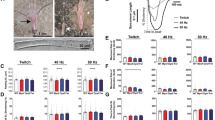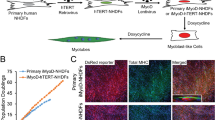Abstract
MUSCULAR dysgenesis in mice is a genetic disease of skeletal muscle caused by the recessive mutation mdg (ref. 1). Muscle fibres in affected mice are paralysed because of the failure of excitation–contraction coupling2,3. Unlike normal myotubes in primary culture, dysgenic myotubes do not contract, either spontaneously or in response to electrical stimulation. The deficiency results from mutation of the gene for the skeletal muscle dihydropyridine receptor4, an essential sarcolemmal component both of excitation–contraction coupling and of the slow calcium-ion channel4,5. It has recently been shown6 that the addition of fibroblasts from normal (but not dysgenic) mice to cultures of dysgenic myotubes can restore spontaneous contractions in a small fraction of these myotubes, but the mechanism for this 'rescue' was not determined. In principle7, if fibroblast nuclei were able to incorporate into myotubes, such nuclei could then supply the missing muscle-specific gene product. We have now investigated this possibility using nuclear, cytoplasmic and plasmalemmal markers. We report that the rescue to contractile ability in genetically paralysed dysgenic muscle is mediated by the previously unrecognized ability of fibroblasts to fuse spontaneously with developing myotubes.
This is a preview of subscription content, access via your institution
Access options
Subscribe to this journal
Receive 51 print issues and online access
$199.00 per year
only $3.90 per issue
Buy this article
- Purchase on Springer Link
- Instant access to full article PDF
Prices may be subject to local taxes which are calculated during checkout
Similar content being viewed by others
References
Pai, A. C. Devl Biol. 11, 82–92 (1965).
Powell, J. A. & Fambrough, D. M. J. cell Physiol. 82, 21–38 (1973).
Klaus, M. M., Scordilis, S. P., Rapalus, J. M., Briggs, R. T. & Powell, J. A. Devl Biol. 99, 152–165 (1983).
Tanabe, T., Beam, K. G., Powell, J. A. & Numa, S. Nature 336, 134–139 (1988).
Rios, E. & Brum, G. Nature 325, 717–720 (1987).
Courbin, P., Koenig, J., Ressouches, A., Beam, K. G. & Powell, J. A. Neuron 2, 1341–1350 (1989).
Blau, H. M. et al. Science 230, 758–766 (1985).
Sanes, J. R., Rubenstein, J. L. R. & Nicolas, J.-F. EMBO J. 5, 3133–3142 (1985).
Bonner, P. H. Devl Brain Res. 38, 233–244 (1988).
Stern, P. L. Nature new Biol. 246, 76–78 (1973).
Banker, B. Q. J. Neuropathol. exp. Neurol. 36, 100–127 (1977).
Koenig, J., Bournaud, R., Powell, J. A. & Rieger, F. Devl Biol. 92, 188–196 (1982).
Rieger, F. et al. Nature 330, 563–566 (1987).
Law, P. K., Goodwin, T. G. & Li, H.-J. Transplantatn Proc. 20, 1114–1119 (1988).
Law, P. K., Goodwin, T. G. & Wang, M. G. Muscle & Nerve 11, 525–533 (1988).
Partridge, T. A., Morgan, J. E., Coulton, G. R., Hoffman, E. P. & Kunkel, L. M. Nature 337, 176–17 (1989).
Beam, K. G., Knudson, C. M. & Powell, J. A. Nature 320, 168–170 (1986).
Sato, T. J. Electron. Microsc., Tokyo 17, 158–159 (1968).
Author information
Authors and Affiliations
Rights and permissions
About this article
Cite this article
Chaudhari, N., Delay, R. & Beam, K. Restoration of normal function in genetically defective myotubes by spontaneous fusion with fibroblasts. Nature 341, 445–447 (1989). https://doi.org/10.1038/341445a0
Received:
Accepted:
Issue Date:
DOI: https://doi.org/10.1038/341445a0
This article is cited by
-
Effects of stress hormone cortisol on the mRNA expression of myogenenin, MyoD, Myf5, PAX3 and PAX7
Cytotechnology (2014)
-
Injecting skin fibroblasts into muscles to express human clotting factor IX cDNA
Science in China Series C: Life Sciences (1998)
-
Making one cell from two
Nature (1995)
Comments
By submitting a comment you agree to abide by our Terms and Community Guidelines. If you find something abusive or that does not comply with our terms or guidelines please flag it as inappropriate.



